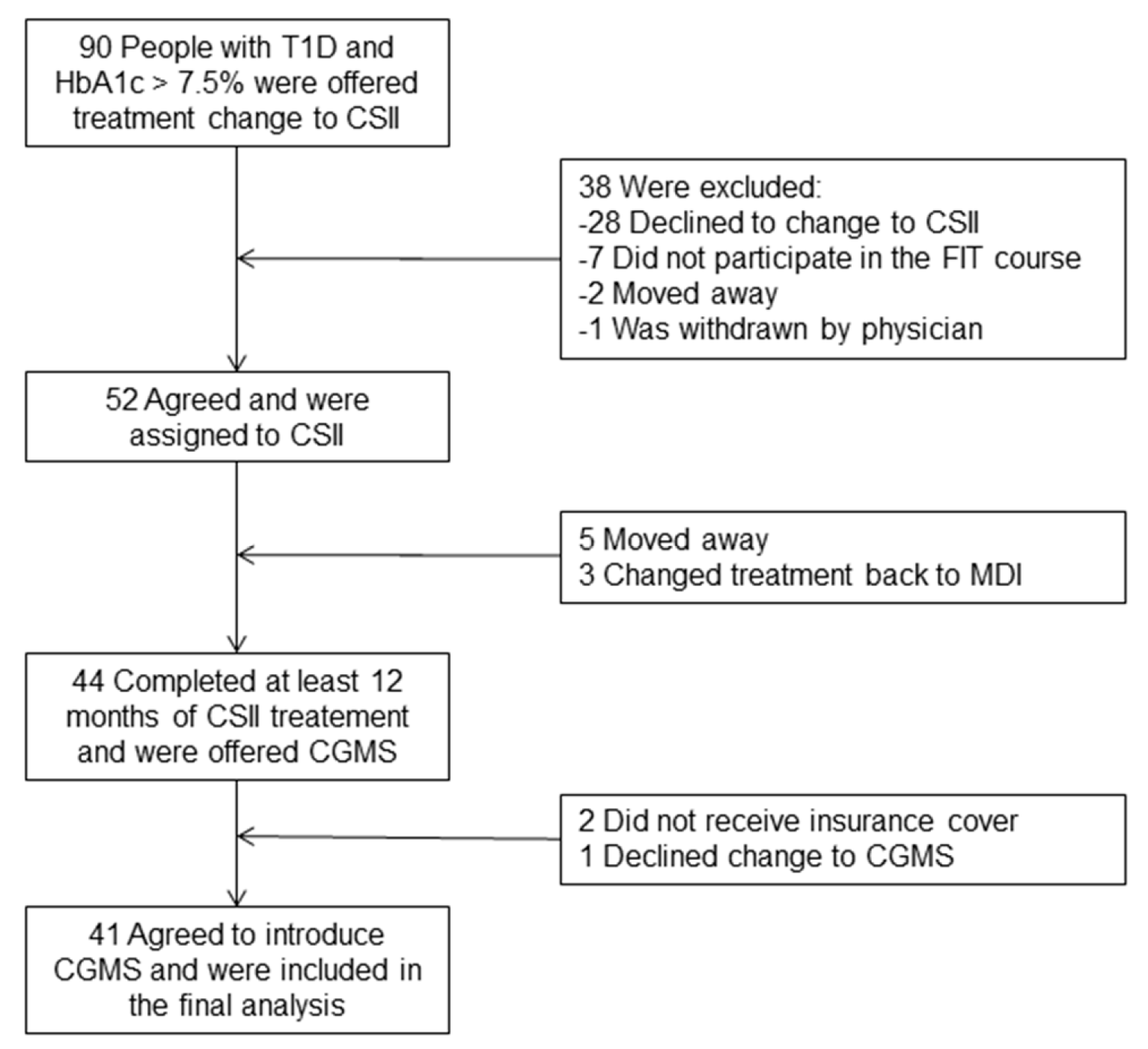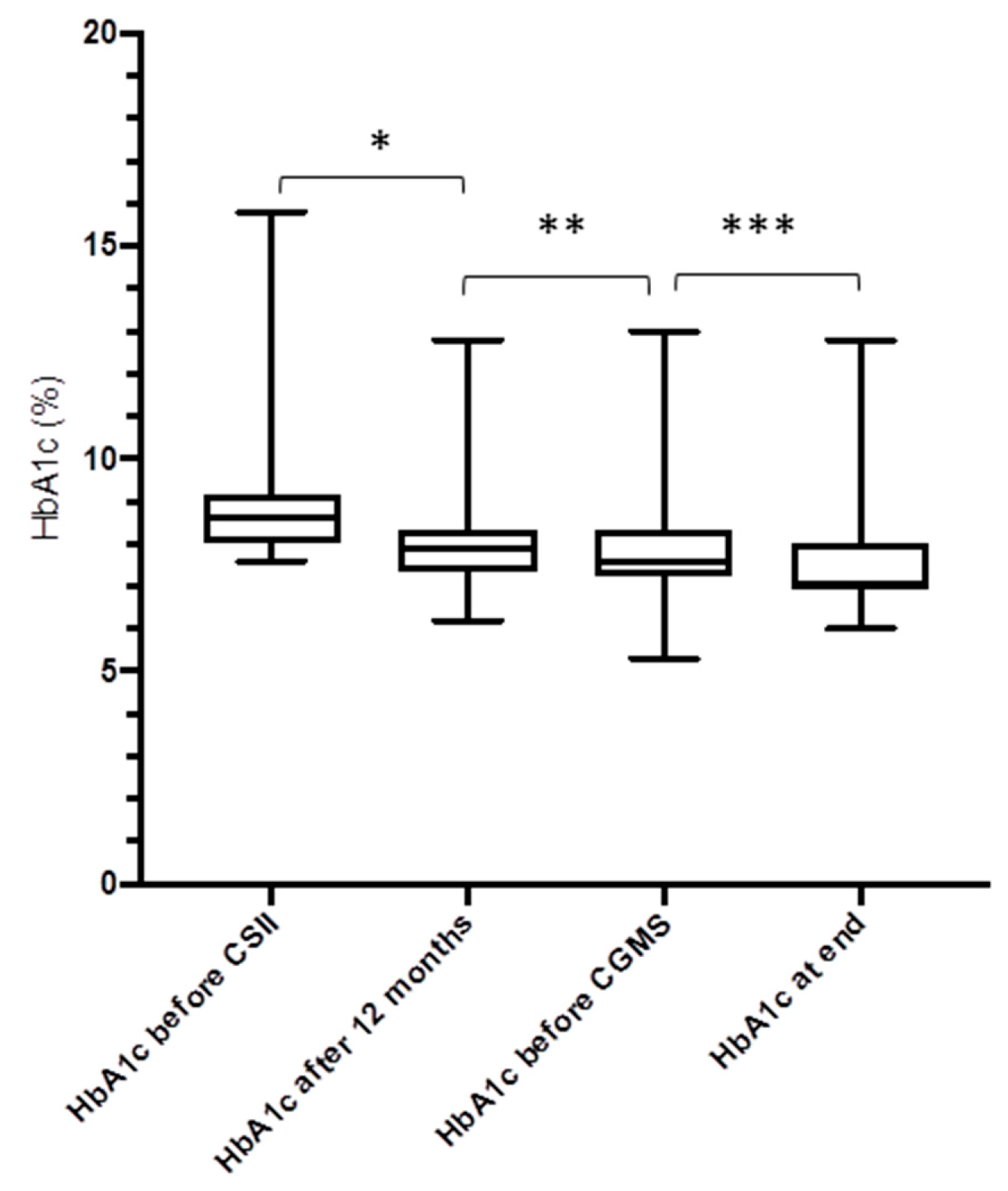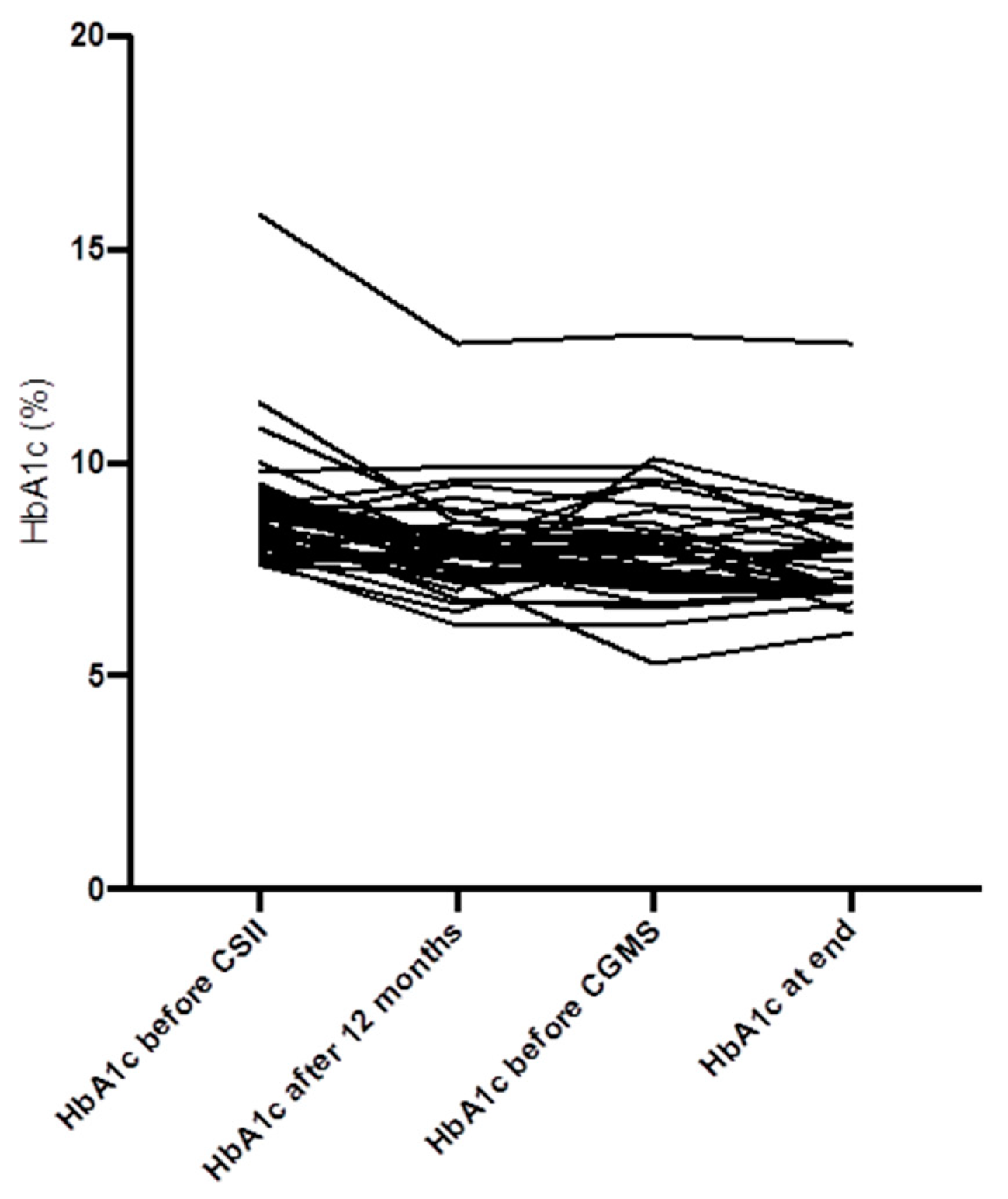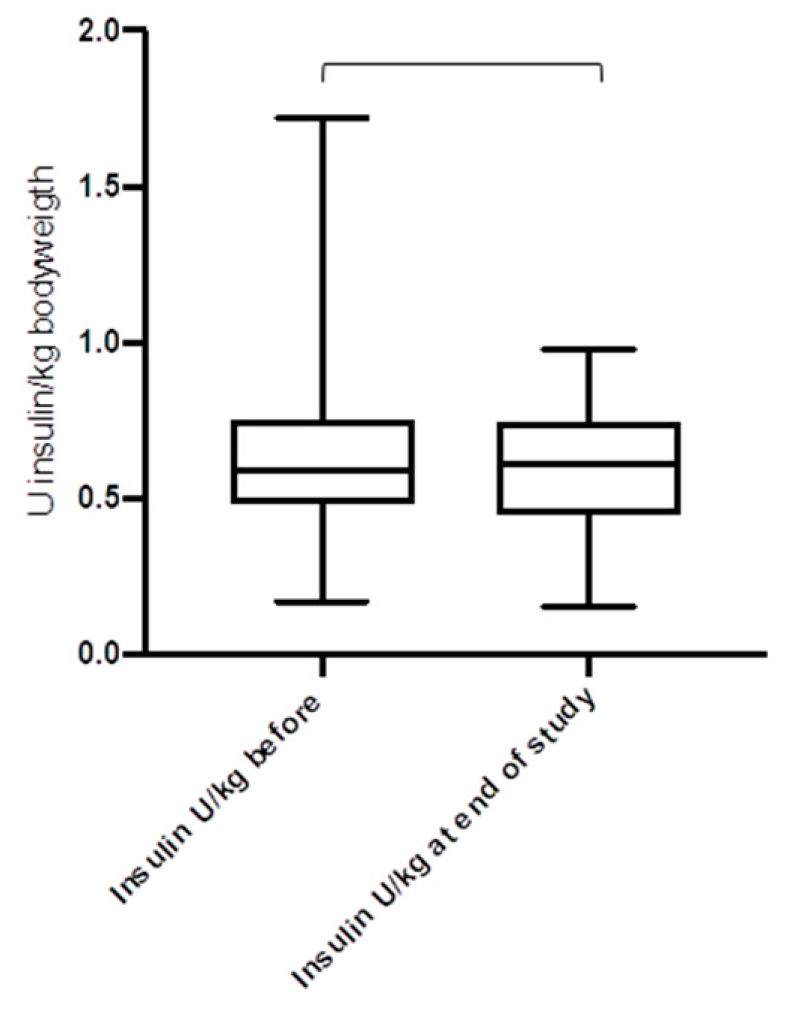Long-Term Effects of Initiating Continuous Subcutaneous Insulin Infusion (CSII) and Continuous Glucose Monitoring (CGM) in People with Type 1 Diabetes and Unsatisfactory Diabetes Control
Abstract
1. Introduction
2. Experimental Section
3. Results
4. Discussion
Author Contributions
Acknowledgments
Conflicts of Interest
References
- Writing Group for the DCCT/EDIC Research Group; Orchard, T.J.; Nathan, D.M.; Zinman, B.; Cleary, P.; Brillon, D.; Backlund, J.Y.; Lachin, J.M. Association Between 7 Years of Intensive Treatment of Type 1 Diabetes and Long-term Mortality. JAMA 2015, 313, 45–53. [Google Scholar] [CrossRef] [PubMed]
- Nathan, D.M.; DCCT/EDIC Research Group. The diabetes control and complications trial/epidemiology of diabetes interventions and complications study at 30 years: Overview. Diabetes Care 2014, 37, 9–16. [Google Scholar] [CrossRef] [PubMed]
- The effect of intensive treatment of diabetes on the development and progression of long-term complications in insulin-dependent diabetes mellitus. The Diabetes Control and Complications Trial Research Group. N. Engl. J. Med. 1993, 329, 977–986. [CrossRef] [PubMed]
- Pickup, J.C. Management of diabetes mellitus: is the pump mightier than the pen? Nat. Rev. Endocrinol. 2012, 8, 425–433. [Google Scholar] [CrossRef] [PubMed]
- Albrecht, D.; Puder, J.; Keller, U.; Zulewski, H. Potential of education-based insulin therapy for achievement of good metabolic control: a real-life experience: Potential of education-based insulin therapy for Type 1 diabetes. Diabet. Med. 2011, 28, 539–542. [Google Scholar] [CrossRef] [PubMed]
- Howorka, K. Funktionelle Insulintherapie; Springer: Berlin/Heidelberg, Germany, 1996. [Google Scholar]
- Grading diabetic retinopathy from stereoscopic color fundus photographs—An extension of the modified Airlie House classification. ETDRS report number 10. Early Treatment Diabetic Retinopathy Study Research Group. Ophthalmology 1991, 98, 786–806. [CrossRef]
- Mameli, C.; Scaramuzza, A.E.; Ho, J.; Cardona-Hernandez, R.; Suarez-Ortega, L.; Zuccotti, G.V. A 7-year follow-up retrospective, international, multicenter study of insulin pump therapy in children and adolescents with type 1 diabetes. Acta Diabetol. 2014, 51, 205–210. [Google Scholar] [CrossRef] [PubMed]
- Rosenlund, S.; Hansen, T.W.; Andersen, S.; Rossing, P. Effect of 4 years subcutaneous insulin infusion treatment on albuminuria, kidney function and HbA1c compared with multiple daily injections: A longitudinal follow-up study. Diabet. Med. 2015, 32, 1445–1452. [Google Scholar] [CrossRef] [PubMed]
- Carlsson, B.M.; Attvall, S.; Clements, M.; Gumpeny, S.R.; Pivodic, A.; Sternemalm, L.; Lind, M. Insulin Pump—Long-Term Effects on Glycemic Control: An Observational Study at 10 Diabetes Clinics in Sweden. Diabetes Technol. Ther. 2013, 15, 302–307. [Google Scholar] [CrossRef] [PubMed]
- Retnakaran, R.; Hochman, J.; DeVries, J.H.; Hanaire-Broutin, H.; Heine, R.J.; Melki, V.; Zinman, B. Continuous subcutaneous insulin infusion versus multiple daily injections: The impact of baseline A1c. Diabetes Care 2004, 27, 2590–2596. [Google Scholar] [CrossRef] [PubMed]
- Pickup, J.C.; Sutton, A.J. Severe hypoglycaemia and glycaemic control in Type1 diabetes: Meta-analysis of multiple daily insulin injections compared with continuous subcutaneous insulin infusion. Diabet. Med. 2008, 25, 765–774. [Google Scholar] [CrossRef] [PubMed]
- Hoogma, R.P.L.M.; Hammond, P.J.; Gomis, R.; Kerr, D.; Bruttomesso, D.; Bouter, K.P.; Wiefels, K.J.; de la Calle, H.; Schweitzer, D.H.; Pfohl, M.; et al. Comparison of the effects of continuous subcutaneous insulin infusion (CSII) and NPH-based multiple daily insulin injections (MDI) on glycaemic control and quality of life: results of the 5-nations trial. Diabet. Med. J. Br. Diabet. Assoc. 2006, 23, 141–147. [Google Scholar] [CrossRef] [PubMed]
- Müller-Godeffroy, E.; Treichel, S.; Wagner, V.M.; German Working Group for Paediatric Pump Therapy. Investigation of quality of life and family burden issues during insulin pump therapy in children with Type 1 diabetes mellitus--a large-scale multicentre pilot study. Diabet. Med. J. Br. Diabet. Assoc. 2009, 26, 493–501. [Google Scholar] [CrossRef] [PubMed]
- Lind, M.; Odén, A.; Fahlén, M.; Eliasson, B. The shape of the metabolic memory of HbA1c: Re-analysing the DCCT with respect to time-dependent effects. Diabetologia 2010, 53, 1093–1098. [Google Scholar] [CrossRef] [PubMed]
- DCCT/EDIC Research Group. Effect of intensive diabetes treatment on albuminuria in type 1 diabetes: Long-term follow-up of the Diabetes Control and Complications Trial and Epidemiology of Diabetes Interventions and Complications study. Lancet Diabetes Endocrinol. 2014, 2, 793–800. [Google Scholar] [CrossRef]
- Lachin, J.M.; Orchard, T.J.; Nathan, D.M.; DCCT/EDIC Research Group. Update on Cardiovascular Outcomes at 30 Years of the Diabetes Control and Complications Trial/Epidemiology of Diabetes Interventions and Complications Study. Diabetes Care 2014, 37, 39–43. [Google Scholar] [CrossRef] [PubMed]
- Roze, S.; Smith-Palmer, J.; Valentine, W.; de Portu, S.; Nørgaard, K.; Pickup, J.C. Cost-effectiveness of continuous subcutaneous insulin infusion versus multiple daily injections of insulin in Type 1 diabetes: A systematic review. Diabet. Med. 2015, 32, 1415–1424. [Google Scholar] [CrossRef] [PubMed]
- Johannesen, J.; Eising, S.; Kohlwes, S.; Riis, S.; Beck, M.; Carstensen, B.; Bendtson, I.; Nerup, J. Treatment of Danish adolescent diabetic patients with CSII—A matched study to MDI. Pediatr Diabetes. 2008, 9, 23–28. [Google Scholar] [CrossRef] [PubMed]
- Pickup, J.C.; Yemane, N.; Brackenridge, A.; Pender, S. Nonmetabolic Complications of Continuous Subcutaneous Insulin Infusion: A Patient Survey. Diabetes Technol. Ther. 2014, 16, 145–149. [Google Scholar] [CrossRef] [PubMed]
- Pickup, J.C. Is insulin pump therapy effective in Type 1 diabetes? Diabet. Med. 2019, 36, 269–278. [Google Scholar] [CrossRef] [PubMed]






| Characteristics | n |
|---|---|
| Male/female (n) | 21/20 |
| Age at diagnosis of T1D (year) | 13.7 ± 11.2 |
| BMI (kg/m2) | 24.0 ± 5.6 |
| Duration of diabetes (year) | 7.8 ± 9.5 |
| Duration of follow-up (year) | 8.9 ± 2.8 |
| Duration of diabetes at study end (year) | 15.9 ± 10.1 |
| HbA1c at study entry (%) | 8.85 ± 1.39 |
| IFCC * (mmol/mol) | 73 ± 8 |
| Daily intake of carbohydrates (g) | 174 ± 67 |
| Severe hypoglycaemia (n/100 patient-years) | 9.7 |
| Other autoimmune disease n (%) | 10 (24%) |
| Observational Group | n |
|---|---|
| Male/female (n) | 35/27 |
| Age at diagnosis (year) | 16.5 ± 12.7 |
| BMI (kg/m2) | 23.7 ± 3.4 |
| Duration of diabetes (year) | 8.5 ± 10.8 |
| Duration of follow-up (year) | 6.8 ± 3.2 |
| Duration of diabetes at study end (year) | 15.5 ± 13.9 |
| HbA1c at study entry (%) | 7.30 ± 0.9 |
| IFCC (mmol/mol) | 56 ± 13 |
| Daily intake of carbohydrates (g) | 216 ± 62 |
| Severe hypoglycaemia (n/100 patient-years) | 14.5 |
| Other autoimmune disease n (%) | 9 (14%) |
| Intervention Group (n = 41) | Observational Group (n = 62) | P Value | |
|---|---|---|---|
| Microalbuminuria, n (%) | 10 (24%) | 13 (21%) | p = 0.62 |
| Diabetic proliferative retinopathy, n (%) | 7 (17%) | 12 (19%) | p = 0.72 |
| Diabetic neuropathy, n (%) | 5 (9%) | 11 (14%) | p = 0.44 |
| Severe hypoglycaemia grade III/IV (n/100 PY) | 2.2 | 4.8 | p = 0.64 |
| Ketoacidosis (n/100 PY) | 1.8 | 1.9 | p = 0.91 |
© 2019 by the authors. Licensee MDPI, Basel, Switzerland. This article is an open access article distributed under the terms and conditions of the Creative Commons Attribution (CC BY) license (http://creativecommons.org/licenses/by/4.0/).
Share and Cite
Senn, J.-D.; Fischli, S.; Slahor, L.; Schelbert, S.; Henzen, C. Long-Term Effects of Initiating Continuous Subcutaneous Insulin Infusion (CSII) and Continuous Glucose Monitoring (CGM) in People with Type 1 Diabetes and Unsatisfactory Diabetes Control. J. Clin. Med. 2019, 8, 394. https://doi.org/10.3390/jcm8030394
Senn J-D, Fischli S, Slahor L, Schelbert S, Henzen C. Long-Term Effects of Initiating Continuous Subcutaneous Insulin Infusion (CSII) and Continuous Glucose Monitoring (CGM) in People with Type 1 Diabetes and Unsatisfactory Diabetes Control. Journal of Clinical Medicine. 2019; 8(3):394. https://doi.org/10.3390/jcm8030394
Chicago/Turabian StyleSenn, Jon-Duri, Stefan Fischli, Lea Slahor, Susanne Schelbert, and Christoph Henzen. 2019. "Long-Term Effects of Initiating Continuous Subcutaneous Insulin Infusion (CSII) and Continuous Glucose Monitoring (CGM) in People with Type 1 Diabetes and Unsatisfactory Diabetes Control" Journal of Clinical Medicine 8, no. 3: 394. https://doi.org/10.3390/jcm8030394
APA StyleSenn, J.-D., Fischli, S., Slahor, L., Schelbert, S., & Henzen, C. (2019). Long-Term Effects of Initiating Continuous Subcutaneous Insulin Infusion (CSII) and Continuous Glucose Monitoring (CGM) in People with Type 1 Diabetes and Unsatisfactory Diabetes Control. Journal of Clinical Medicine, 8(3), 394. https://doi.org/10.3390/jcm8030394





